USB 3.2 Gen 2x2 State of the Ecosystem Review: Where Does 20Gbps USB Stand in 2020?
by Ganesh T S on October 5, 2020 10:30 AM EST- Posted in
- Storage
- SSDs
- Western Digital
- SanDisk
- ASMedia
- USB 3.2 Gen 2x2
PCMark 10 Storage Bench - Real-World Access Traces
There are a number of storage benchmarks that can subject a device to artificial access traces by varying the mix of reads and writes, the access block sizes, and the queue depth / number of outstanding data requests. We saw results from two popular ones - ATTO, and CrystalDiskMark - in a previous section. More serious benchmarks, however, actually replicate access traces from real-world workloads to determine the suitability of a particular device for a particular workload. Real-world access traces may be used for simulating the behavior of computing activities that are limited by storage performance. Examples include booting an operating system or loading a particular game from the disk.
PCMark 10's storage bench (introduced in v2.1.2153) includes four storage benchmarks that use relevant real-world traces from popular applications and common tasks to fully test the performance of the latest modern drives:
- The Full System Drive Benchmark uses a wide-ranging set of real-world traces from popular applications and common tasks to fully test the performance of the fastest modern drives. It involves a total of 204 GB of write traffic.
- The Quick System Drive Benchmark is a shorter test with a smaller set of less demanding real-world traces. It subjects the device to 23 GB of writes.
- The Data Drive Benchmark is designed to test drives that are used for storing files rather than applications. These typically include NAS drives, USB sticks, memory cards, and other external storage devices. The device is subjected to 15 GB of writes.
- The Drive Performance Consistency Test is a long-running and extremely demanding test with a heavy, continuous load for expert users. In-depth reporting shows how the performance of the drive varies under different conditions. This writes more than 23 TB of data to the drive.
Despite the data drive benchmark appearing most suitable for testing direct-attached storage, we opted to run the full system drive benchmark as part of our evaluation flow. Many of us use portable flash drives as boot drives and storage for Steam games. These types of use-cases are addressed only in the full system drive benchmark.
The Full System Drive Benchmark comprises of 23 different traces. For the purpose of presenting results, we classify them under five different categories:
- Boot: Replay of storage access trace recorded while booting Windows 10
- Creative: Replay of storage access traces recorded during the start up and usage of Adobe applications such as Acrobat, After Effects, Illustrator, Premiere Pro, Lightroom, and Photoshop.
- Office: Replay of storage access traces recorded during the usage of Microsoft Office applications such as Excel and Powerpoint.
- Gaming: Replay of storage access traces recorded during the start up of games such as Battlefield V, Call of Duty Black Ops 4, and Overwatch.
- File Transfers: Replay of storage access traces (Write-Only, Read-Write, and Read-Only) recorded during the transfer of data such as ISOs and photographs.
PCMark 10 also generates an overall score, bandwidth, and average latency number for quick comparison of different drives. The sub-sections in the rest of the page reference the access traces specified in the PCMark 10 Technical Guide.
Booting Windows 10
The read-write bandwidth recorded for each drive in the boo access trace is presented below.
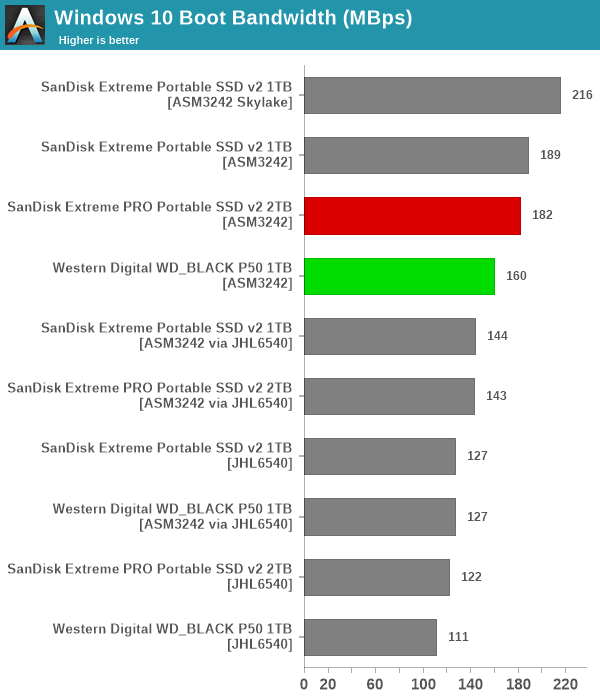
USB SuperSpeed 20Gbps doesn't matter for the boot process - in fact, the Extreme Portable SSD v2 using the SN550E behind a USB 3.2 Gen 2 (10 Gbps) bridge scores better than the P50 and the Extreme PRO v2 on the Haswell testbed in this benchmark.
Creative Workloads
The read-write bandwidth recorded for each drive in the sacr, saft, sill, spre, slig, sps, aft, exc, ill, ind, psh, and psl access traces are presented below.
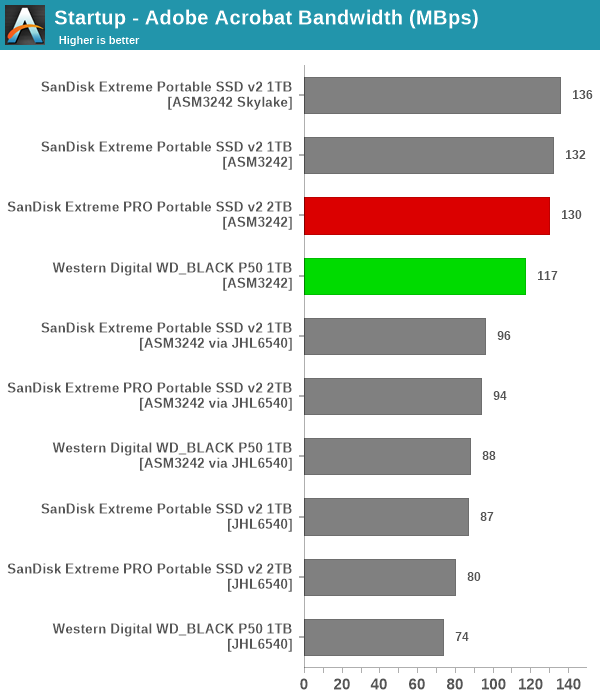
These workloads also seem to get little benefit from the move to USB SuperSpeed 20Gbps. In almost all cases, the SanDisk Extreme v2 performs better than the Extreme PRO v2 on the same testbed. The P50 seems to suffer from some handicaps for these types of workloads.
Office Workloads
The read-write bandwidth recorded for each drive in the exc and pow access traces are presented below.
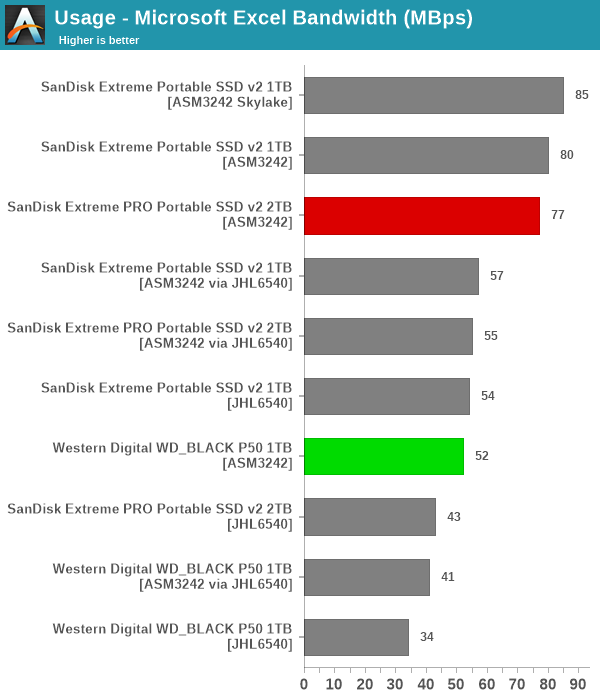
The trend seen in earlier PCMark 10 storage workloads repeats here - the Extreme edging out the Extreme PRO v2 slightly, while the P50 lags well behind.
Gaming Workloads
The read-write bandwidth recorded for each drive in the bf, cod, and ow access traces are presented below.
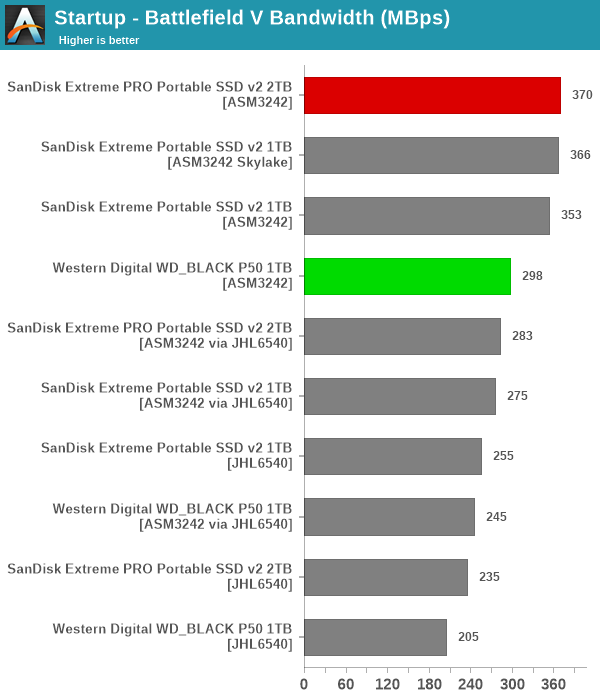
This section finally sees the P50 live up to its billing as a game drive - in the Call of Duty loading times, it finally scores almost as well as the Extreme PRO v2, and the Extreme v2 lags well behind. However, overall, the Extreme PRO v2 seems to be a better fit for gaming workloads.
Files Transfer Workloads
The read-write bandwidth recorded for each drive in the cp1, cp2, cp3, cps1, cps2, and cps3 access traces are presented below.
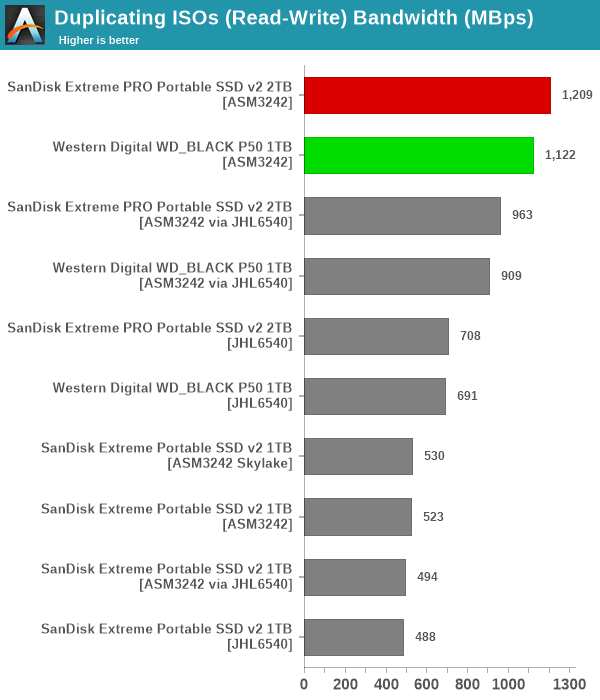
In most workloads, the USB SuperSpeed 20Gbps drives come out on top, with the Extreme PRO v2 slightly edging out the P50.
Overall Scores
PCMark 10 reports an overall score based on the observed bandwidth and access times for the full workload set. The score, bandwidth, and average access latency for each of the drives are presented below.
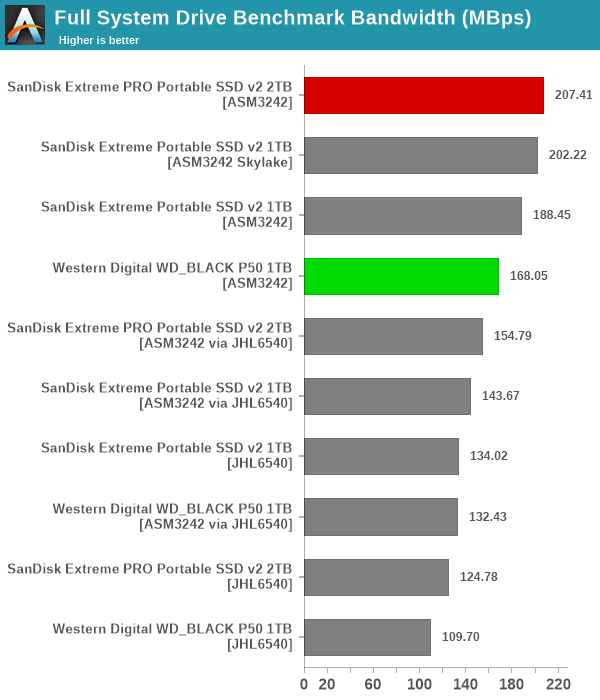
The WD_BLACK P50 scores are a bit behind the Extreme PRO v2 and the Extreme v2 when considered on a testbed-by-testbed basis. When limited by the host port to 10Gbps, the gulf is not significant, though. It may just be that Western Digital has tweaked the firmware of the P50 to cater to gaming workloads alone.










81 Comments
View All Comments
epobirs - Wednesday, October 7, 2020 - link
This was tried and rejected by the world already, under the name SATA Express. A whole generation of motherboards shipped with SATA Express ports but nobody made any drives of any sort to use with the port. (IIRC, WD had a demo at Computex one year.) The closest I ever came to using a SATA Express port for anything was the clever ASrock adapter that let you repurpose the port to create a pair of USB 3.1 ports, Type A and C with 10Gb/s support, that went into a front drive bay.Once NVMe caught on it just didn't make much sense to pursue a direct successor to SATA.
https://en.wikipedia.org/wiki/SATA_Express
Hrunga_Zmuda - Tuesday, October 13, 2020 - link
Exactly.StormyParis - Monday, October 5, 2020 - link
Performance is one thing, and I understand it's the primary concern in some cases.In most cases though, compatibility not performance is the main issue, and we run into 2 problems:
1- it's hard to know what *should* work. A USB-C port doesn't mean anything at all by itself, there's not even a color code as a quick hint. Any consumer tech that requires to RTFM is failing at a very basic level.
2- even stuff that should work sometimes doesn't. Apparently USB-PD charging on MacBooks works much better on one side than on the other. I've seen a lot of issues with video, even simple storage/LAN stuff.
The goal of USB is laudable. The way they're going at it is laughable.
drexnx - Monday, October 5, 2020 - link
yeah, USB used to mean it just worked, didn't have to think about it or read anything. Literally plug and play.now? no clue, unless the mfg puts iconography to let you know what each port can do.
imaheadcase - Monday, October 5, 2020 - link
Even with speeds it varies so wildly by device its silly. The real only advantage i found with a SSD for portable drive is the size and weight is better. Performance is Meh, because most people aren't using it for own devices so much as plugging it into someone elses. I've seen top selling drives that will barely get usb 2.0, and even then the read/write to usb speed is insanely different between devices.imaheadcase - Monday, October 5, 2020 - link
I forgot to mention that even cables mater so much, i'm not talking about scam monster cable stuff, i'm talking just even same brand to brand, can get a bulk 20 pack of usb-c cables, and each one could be different in speed.BeethovensCat - Monday, October 5, 2020 - link
Agree!! A complete joke! Have Patriot and a Sandisk SSD and they don't work with the same USB C cable. How can USB have come to this?drexnx - Monday, October 5, 2020 - link
this is really getting back to the dark ages of RS232 where there were different baud rates for different peripherals, now that I think about itdontlistentome - Monday, October 5, 2020 - link
I'll bite. Bit of a correction on diagram, more complexity needed.USB 1.0 was 1.5Mbps, USB 1.1 was 12Mbps
repoman27 - Monday, October 5, 2020 - link
Nope. USB 1.0 defined both low-speed 1.5 Mbit/s and full-speed 12 Mbit/s signaling. It just sucked, which is why 1.1 was released to fix a bunch of issues that were encountered in real-world implementations.